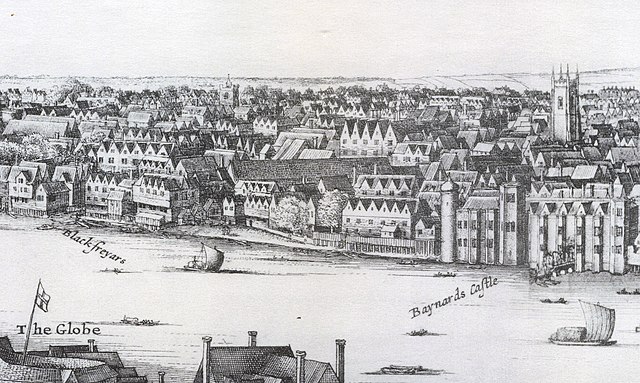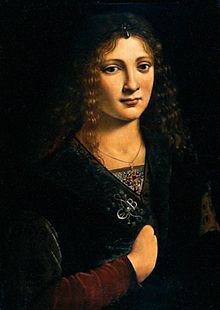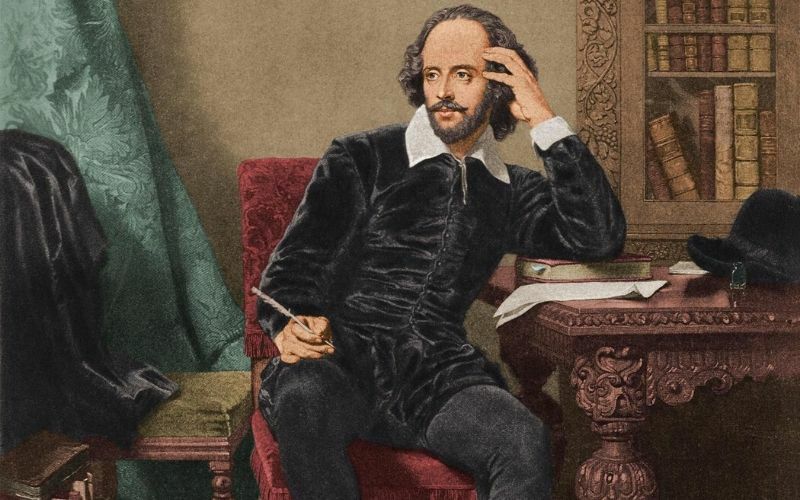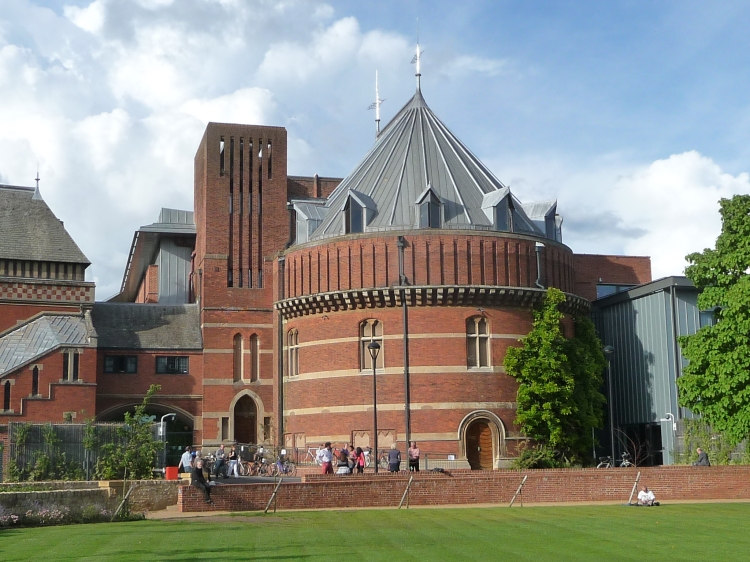
In his book “Shakespeare And His World”, (published in 1970 by Thames & Hudson) the renowned Shakespearean scholar, F.E. Halliday attempts to denounce the statement or view of other academics of the time that very little was then known about the playwright William Shakespeare. On the fly-leaf he writes:
“The object of this book,” as Mr. Halliday writes in the preface, “is quite simply to describe what we know about Shakespeare’s life after three centuries of discovery, and to illuminate and animate the story by illustration. And what we know will probably surprise a great many people – reassuring them, incidentally if they have any doubts, that William Shakespeare of Stratford-upon-Avon really was the author of the plays attributed to him.”
In the preface written while resident in Cornwall in the summer of 1956 in the book he goes on to affirm:
“It is, unfortunately, a common delusion that little or nothing is known about the life of Shakespeare. In fact quite a lot is known, thanks to the devoted labours of a succession of English and American authors, from Malone and Halliwell/Phillips in the eighteenth and nineteenth centuries to C.W. Wallace and Leslie Hotson in our own day, much has been discovered, and still being discovered; far more indeed, than we had any right to expect concerning a dramatist who lived the greater part of his life, and died, in an obscure provincial town.”
His book is inspired apparently by the fact that “It is doubly unfortunate that it should so generally be assumed that we know little about Shakespeare.” He goes on to cite a recent theory circulated by Celia Bacon and other writers that it was Sir Francis Bacon who wrote Shakespeare’s plays and poetry.
He says: “Although this book has not been written to refute this nonsense, it should do something incidentally to dispel it.” Adding modestly: “So far as I am aware nothing quite like it has been attempted before, and the illustration of so much biographical material, documents as well as portraits and places, should serve as a reassurance that the man who wrote the thirty six plays of the Folio was William Shake-speare of Stratford-upon-Avon. It is a reasonable hypothesis.”

Interestingly enough the documentation he provides, although in parts inaccurate and interesting works more towards denying the proposition that Shakespeare was Shaxpere! For example, although Halliday addresses the author as “Shake-speare” or “Shakespeare” throughout the book, none of the documentation illustrated actually spells his name consistently in that manner, instead it is written in every conceivable alternative manner: (eg: Shaxpere, Shagsper, Shacksper, and Shakeshafte). Reading the book further, it served merely to amuse me personally and in places made me laugh hysterically whenever the scholar contradicted himself or when it was obvious he deliberately omitted to mention the crucial piece of evidence which would destroy his subjective propositions and suppositions about the life of Will Shaxpere. Although I am an ardent Oxfordian, the reason I bought the book was to observe how a conventional Stratfordian had come to the wrong conclusion, having listed and collated so much material evidence, that Shaxpere was Shakespeare. The first documentary evidence he provides is an entry in the Stratford Parish register of the baptism of the son of John Shakspere on the 26th April 1564 of one Guilemus filius Johannes Shakspere, followed by three crosses (XXX) signifying the fact that the un-named witnesses could not actually sign their own signature. What he fails to mention is that England adhered to the Old Julian Calendar and the dates of the time were at least 11 days behind those who took on the new Gregorian calendar. This means that William Shaxpere was born sometime in May not April. He then provides an illustration showing the location of Shakspere’s house on Henley Street which was adjacent the Gild Chapel, New Place and the half-timbered Grammar School built above the Gild Hall. At this point he writes:
“It is high time that the mischievous conception of Shakespeare as an inspired peasant was finally dispelled. His mother was a member of a great family, his father an ambitious and exceptionally able man of business, and though there is no record (why should there be?) of his schooling, it is inconceivable that such parents would let slip the opportunity of sending him to the local grammar school.”

Adding incidentally that the grammar school was one of the best in the country, and that “We must, therefore, imagine Shakespeare during the decade of the seventies sitting at his desk in the schoolroom over the Council Chamber, where his father helped to shape the fortunes of the town, first at the feet of Simon Hunt, a devout Catholic at heart, and then of the Welshman, Thomas Jenkins, whom he was later lovingly to caricature as Sir Hugh Evans in the Merrie Wives of Windsor”.

He then goes on to describe the curriculum and books available at the grammar school such as the Geneva Bible and Lily’s Latin Grammar, “as used by Shakespeare”. Aside from peppering a large part of the book with other Elizabethan artefacts and events that took place chronologically around the same time such as the performance of “A Midsummer Night’s Dream” by the Earl of Leicester’s Men financed by Sir Robert Dudley at Kenilworth in the summer of 1575. A time Halliday muses when “The pleasures were on a princely scale, and no doubt Shakespeare played truant on the day of the great water pageant of the Lady of the Lake, and wondered about Arion riding on a dolphin’s back.” At this point I am literally roaring with laughter seeing the author has surpassed himself in total denial of his mental faculties. Let us unpick what he has said and see how he has conflated one piece of evidence with a piece of conjecture: that when William Shakespeare was still at school he played truant in order to attend a pageant at Kenilworth Castle where Queen Elizabeth 1st was staying. So, was W. Shaxpere invited to attend? Obviously not since there is no evidence he was at school let alone privy to the event and could not have been there being a young commoner. His father was a bailiff then, not an alderman so would not have been responsible for payments to player’s companies.

Then Halliday mentions the first time Shakespeare attended a play with the Queene’s Players in Stratford when his father was the town bailiff and chief ale-taster in 1568-9. At that time W. Shaxpere was a mere 4-years old, hardly old enough to appreciate any form of drama. By the time of the next date referred being 1575 he would have been ten years old, his father had become alderman in 1571 and would subsequently experience financial problems by 1579 having failed to repay a loan of £40 from his brother-in-law he then had to mortgage his wife’s (Mary Arden) Wilmcote property and her share in the Snitterfield estate. Halliday fails to mention or elaborate over the so-called “Lost Years” of Shakespeare’s life and instead gives various illustrations of books that Shaxpere might have read such as John Lyly’s “Euphues, An Anatomy of Wit” (dedicated to Edward de Vere 1578) and the “Lives of the Noble Grecians & Romans” by Sir Thomas North (1579). John Lyly was then a close collaborator and secretary of Edward de Vere, while Thomas North was for some time Edward de Vere’s tutor when he was a ward of Lord Burghley. The topic then turns to the marriage of W. Shaxpere and a woman eight years his senior with a variety of differing surnames, namely; Anne Whateley of Temple Grafton (marriage licence), Anne of Shottery (parish records), and finally Agnes Hathawaye (her father’s will). By 1582 in several parish and church records (eg: Temple Grafton Church where they were married) W. Shaxpere (Clerk’s Records) is being spelled Shakspere or Shagspere (the latter spelling is on the licence bond).

When it was disclosed that Anne Hathawaye was with child, John Shaxpere’s accomplices, Fulke Sandells and John Richardson had secured a licence from the Bishop of Worcester late 1582 without having to post three consecutive banns with a bond of £40 and the document is unashamedly illustrated in Halliday’s book although it is far too small to read in detail. For some unknown reason they were given the family names of Sadler in the parish register (presumably after his long term friend Hamnet Sadler, who had a large family of his own) perhaps to distance them from the Shaxpere name. Having shown details of the birth of Susanna (26/05/1583) and the twins Judith and Hamnet on the 2nd February 1585, Halliday naturally turns his attention to life in London where W. Shaxpere relocated to escape no doubt his parental responsibilities and avoid any further scandal surrounding his father’s finances. However, he cannot resist the temptation of mentioning that Shaxpere was presumed to have poached deer from the Charlecote Estate of Sir Thomas Lucy (a story he suggests was based on some petty trespass and not specifically theft). He suggests that W. Shaxpere decided to leave for London around 1587 when Worcester’s Men played in Stratford and apparently lured him away from the provincial boredom or rather when his father lost his status as Alderman in Stratford and was being sued by his brother Henry Shaxpere for his failure to repay a loan. He goes on to suggest that his fellowship with the printer Richard Field would have given him opportunities for employment but does not provide any evidence that W. Shaxpere even knew Richard Field at that time.

Then Halliday turns his attention to Henslowe’s diary (1591) where the first record of a performance of a Shakespeare play is listed, namely Henry VIth, Part One and Thomas Nashe’s reference in Piers Penniless in 1592 to a performance of the same play. He concludes therefore that by 1592 (within 5 years of his residence in London) W. Shaxpere had already written the three parts of Henry VIth and had acquired a “considerable reputation as a dramatist”, enough to arouse the hostility of the poet and playwright, Robert Greene who using the dramatist’s own words condemned him as an “Upstart Crow”. In his early career it is assumed that he would have written Henry VIth parts 1, 2 and 3, Richard the Third as well as A Comedy of Errors and The Taming of a Shrew. To do this he would have had to have read or possessed several important literary sources often quoted by academics for example:

Raphael Holinshed’s The Chronicles of England, Scotland and Ireland. (2nd ed., 1587). Samuel Daniel’s The Civil Wars between the Two Houses of Lancaster and York (1595-1609). He would also have read an anonymous work entitled The Famous Victories of Henry the Fifth (c. 1586). Other important sources would be William Baldwin’s edition of The Mirror for Magistrates (1559 ed.), John Stow’s (1525-c.1605) The Chronicles of England (1580), Edward Hall’s (1498-1547): The Union of the Two Noble and Illustre Families of Lancaster and York (3rd. ed., 1550), the seminal work by Robert Fabyan (?-1513): New Chronicles of England and France (1516) and Richard Grafton’s (c.1512-c.1572): A Chronicle at Large of History of the Affayres of England (1516) as well as John Hardyng’s The Chronicle of John Hardyng (1543) and to have read John Foxe’s, The Book of Martyrs (4th ed., 1583). He would also have been acquainted with Edmund Spenser’s (c.1552-99): The Faerie Queene (1590) – descriptions of the Sun at 2.1. To have been conversant with Arthur Brooke’s, The Tragical History of Romeus and Juliet (English translation in 1562) – Queen Margaret’s speech at 5.4. Furthermore, he would have been familiar with Thomas Kyd’s, (1558-94) A Spanish Tragedy (1588-9) and Soliman and Perseda (1590). He might have come across an anonymous ballad: “A Merry Jest of a Shrewede and a Curste Wyfe” (printed 1550). So, since there were no public libraries in London at the time, where did W. Shaxpere acquire the funds to purchase these literary works as well as no doubt the Geneva Bible, or Book of Psalms having left Stratford with very little financial support from his bankrupt father?

To write his first comedy he would of course have had access to the works of Plautus (c.254-184 BC); specifically Menaechmi (“The Twins”) performed 1592 with an English translation by William Warner, printed 1595) as well as Amphitryon (Latin version) and to have read George Gascoigne’s (1542-77) own play Supposes (performed 1566, and published in 1573, 1587). He would also need to have been familiar with the translation of Italian drama, I Suppositi (1509) or become acquainted with the influence of the Italian Commedia dell’Arte in purely dramatic terms. However, the Italian Commedia dell’Arte never performed in England although they toured other parts of Europe so how did William Shagspere, who had never travelled abroad become so well acquainted with its characters, style and themes unless of course he had secretly travelled to Italy? Furthermore, there is no evidence that the Shagspere family owned any books and this glaring disparity has been explained by Stratfordian academics with the supposition that either the theatre manager Richard Burbage or his fellow printer from Stratford, namely Richard Field had given him access to these books for the purpose of writing his plays. So, we are simply expected to believe that without any dramatic training or literary experience he produced those superlative works single-handedly and then arranged for them to be performed on the London stage. This apparent meteoric ascent from bucolic obscurity to literary genius in the space of five years is the only explanation that eminent biographers have been able to proffer to account for his being the author and playwright of Shakespeare’s work.
Then in 1595 it is alleged he had joined the Lord Chamberlain’s Men and in March *1595 he is mentioned in the lists as receiving payment for his performance in the play “A Comedy of Errors”, played at Gray’s Inn. However, as usual trouble was stalking our now middle-aged Shaxpere as in 1596 the London court records mention the following:
1596 – Michaelmas – Court record. William Wayte “swore before the Judge of Queen’s Bench that he stood in danger of death, or bodily hurt,” from “William Shakspere” and three others. “The magistrate then commanded the sheriff of the appropriate county to produce the accused … who had to post bond to keep the peace, on pain of forfeiting the security”.
By 1598 we find the following records, the first of which we should take with a pinch of *salt or should we say mustard?
*1598 – List of Actors. In the initial presentation of Ben Jonson’s “Every Man In His Humour”, “Will Shakespeare “was a “principall Comoedian”.
Meanwhile, back in Stratford-upon-Avon:
1598, 1st December – Bill of sale. Chamberlain’s Accounts Wyllyn Wyatt Chamberlin “Pd to Mr. Shakspere for one load of stone xd”.
1598, 24th January – Letter – Abraham Sturley wrote to his brother-in-law that “our countriman Mr Shaksper is willing to disburse some stone upon some od yardeland or other Shottrei or neare about us…”
1598, 4th February – List of Hoarders. Shakspere is named as having illegally held 10 quarters (80 bushels) of malt or corn during a shortage.
1598, 1st October – Tax record. In the King’s Remembrancer Subsidy Roll, Shakspere is listed as a tax defaulter who failed to pay an assessed 13s..4d
1598, 25th October Letter. Richard Quiney wrote an undelivered letter asking Shakspere for a £30 loan, the letter could very easily have been a forgery.
1598 September – Tax record. In the Lord Treasurer’s Remembrancer
Accounts of Subsidies, Shakspere is listed among those in Bishopgate ward who had moved out of the district.
Remission of taxes was also finally granted in 1599 and Quiney’s expenses, the sum of £44 were paid by the Exchequer. Sir Edward Greville of Stratford, Lord of the Manor and son of Lodowick Greville was the cousin of Fulke Greville II, the courtier poet, who was obliging in this regard although somewhat belatedly. In the first chapter of “A Companion to Shakespeare Studies” (Cambridge University Press-1934) Harvey Granville-Barker and G.B. Harrison write with candour:

“Of the life of Shakespeare little is known. No biography of him was attempted until nearly a century after his death. Floating traditions then collected, partly at Stratford and in the neighbourhood, partly from theatrical circles in London, clothed the bare facts for which there was documentary evidence with some amount of flesh and blood. The portrait of Shakespeare remains substantially unchanged by the laborious research of two centuries more. Most modern Lives expand their contents partly by accumulation of details however minute and bearing however remotely on Shakespeare himself; and much more largely by inference and conjecture based on treatment of the plays and the sonnets as veiled or unconscious autobiography.”
The attempt to substantiate W. Shaxpere as a man of property and elevated status with his shares in the Blackfriar’s theatre and as a co-owner of the lease of the Blackfriar’s Gatehouse does not stand up. Both these assets were not bequeathed or passed on to his family or even mentioned in his last will and testament and remain “red herrings” in a dubious attempt to support the great literary cover-up. At the time of writing no evidence of his marriage to Agnes Hathaway existed except the issue of a marriage licence suggesting intent. Where and when he was married was completely unknown, so we can presume the actual evidence of his marriage provided by Halliday appeared sometime in the 1940’s. The “Companion to Shakespeare Studies” states clearly: “But for the years 1585-92 (his own 21st to 28th years) there are no first hand facts.” This appears to be the beginning of the “Lost Years” theory to substantiate the total absence of viable evidence to which so much conjecture has subsequently been applied by numerous Shakespeare scholars.
In the seventeenth century anecdotal stories continue to be generated to fill the void by W. Fulman a rector of Mersey Hampton, Gloucestershire of the lad, Shaxpere working as a butcher’s apprentice before running away to London. This was supported by similar claims by a clergyman of Stratford, near Butler’s Marston of anecdotal evidence that his first job at the theatres was holding the horses of spectators and that he fraternised with the landlord’s wife Jane Davenant while on his way through Oxford. The Cambridge Companion goes on to say:
“These stories have, in their main lines, no inherent improbability. But at the best they are confused and uncertain, and still leave the earlier London years, no less than those previous to them, an almost complete blank.”
Of the probability that W. Shaxpere was an actor, again very little concrete evidence appears to deny or confirm the supposition by Beeston, although the author of the “Historia Histrionica” (1689) notes he was “a much better poet than player”. The poet Nicholas Rowe’s attempts to affirm without proof that he took the part of the Ghost in Hamlet, another source linked him to the role of Adam in a performance of “As You Like It”, despite the fact that he was never known to have assumed principal parts. The Life of Shakespeare closes with the remark:
“The inverted pyramids of purely conjectural biography which have been and still piled up on the slender basis of ascertained fact, and on the slighter additions of legend which may be accepted as authentic or highly probable, may be dismissed here without notice.”
See also “Shakespeare’s Signatures” or “Shakespeare’s Coat of Arms”
| The links to my publications “Shakespeare’s Qaballah”, a Companion to Shakespeare Studies and my anthology of poetry, “Parthenogenesis” are as follows: |
https://www.amazon.com/dp/8182537193
https://www.cyberwit.net/publications/1721
Website: www.qudosacademy.org

